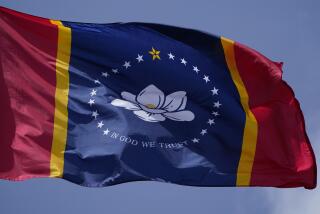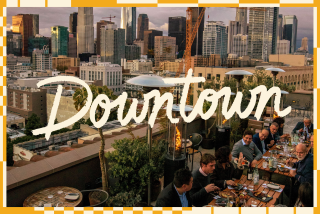Blues’ hues in the Delta
- Share via
INDIANOLA, MISS. — He started out here 60 years ago, singing the blues on a street corner for dimes. Now, less than three blocks from that corner, the legendary B.B. King will soon have his own museum.
The B.B. King Museum & Delta Interpretive Center is set to open Sept. 13, three days before his 83rd birthday. The museum honors the man who Rolling Stone magazine says “is universally recognized as the leading exponent of modern blues.”
It is but one in a surprisingly long list of attractions in the Mississippi Delta -- surprisingly long only if you’ve never visited the region.
Visitors can see where the blues developed and where it’s still played; where people risked their lives -- and sometimes lost them -- in the name of civil rights; where the designs of a Smithsonian-caliber embroiderer have captivated viewers; where the state’s famous clay is turned into pottery.
At first glance, the Mississippi Delta seems stark. Its flat-as-a-tabletop landscape occupies the northwestern section of the state, stretching from Memphis in neighboring Tennessee to Vicksburg, from the Mississippi River to the Yazoo River. Yet this ordinary land has spawned extraordinary creativity and courage.
The town of Indianola, smack in the middle of the Delta, wanted to honor King not just for his musical genius but also for his influence on scores of other musicians, including blues guitarist Buddy Guy and Beatle John Lennon.
I toured the museum this spring (it was still under construction) with Connie Gibbons, the museum’s executive director. I saw where the guitar studio would be located, where visitors can learn basic chord structures. Gibbons told me about the displays that would depict “what it was like to leave the small world of the Mississippi Delta and go to Memphis,” where King got his own radio show in the late 1940s.
The museum complex also incorporates a brick cotton gin where King worked as a young man, when cotton was king in the Delta. Today, silos holding corn to produce ethanol have replaced most of the gins. But in years past, cotton grew on large plantations such as Dockery Farms, between Cleveland and Ruleville north of Indianola.
Dockery was a company town of about 400 families at its zenith in the 1920s. “There were three churches,” Luther Brown said as he led a tour of college students from Texas. “It had its own doctor, post office, telegraph office, commissary and even used its own money -- Dockery dollars,” said Brown, an associate dean at Delta State University in Cleveland.
A blue sign -- blue for the Blues Trail -- near the weathered old buildings describes the influence of Charley Patton, a sharecropper at Dockery Farms before becoming an itinerant musician. He’s called the “father of the Delta blues,” and his guitar style has been described as “percussive and raw.” Another musician once said he sang as though someone were choking him.
His marker at Dockery is one of 120 that the Mississippi Blues Commission is erecting around the state (www.msbluestrail.org). The website also contains a list of regular gigs and special blues events in Mississippi.
While I was with the students at Dockery Farms, I ran into blues fan Chris Rogers of Brighton, England, and his wife, Louise. They were launching a tour of Delta landmarks “to feel part of” the music Chris loves. On their agenda: Clarksdale, 48 miles north of Indianola, to visit the Delta Blues Museum, where one exhibit includes remnants of the cabin in which bluesman Muddy Waters lived as a sharecropper, as well as actor Morgan Freeman’s Ground Zero Blues Club and the Riverside Hotel (once a hospital), where blues diva Bessie Smith died in 1937 after a car crash.
“The room where Bessie died is never occupied,” Rogers said, “but if you ring the front doorbell, ask for Rat, then he’s happy to show you around.”
Mississippians are obliging that way.
HISTORY LESSON
You can’t come to the Delta without running headlong into Mississippi’s past. That was what the students from Sam Houston State University in Huntsville, Texas, had come to explore. Along with professors John Strait and Jim Tiller, they were on a field trip that Strait called an exploration of “race, blues, rock ‘n’ roll and the geography of the Mississippi Delta.” I tagged along for a day.
After we left Dockery, we stopped in Ruleville at the grave of civil-rights champion Fannie Lou Hamer, whom I had interviewed for a series of newspaper articles in 1973 and later wrote a book about. Even though she was in ill health then -- she died in 1977 -- she was still a commanding presence who spoke eloquently about the evils of racism.
In 1962, Hamer went to Indianola to try to register to vote, earning her such enmity from residents and law enforcement that she received death threats. Arrested in 1963 for trying to desegregate a Mississippi bus station, Hamer was beaten so savagely that she was permanently disabled.
When I interviewed her 10 years after that attack, neither of us could have imagined that Indianola would one day erect markers saying, “Home of Fannie Lou Hamer,” but it has.
After revisiting history, the student group headed out for Po’ Monkey’s, a noted juke joint six miles north of Cleveland. A few of these road houses survive from the days when they were among the few places that black field workers could go to drink and dance.
The building is an old sharecropper’s shack in which every available inch inside is plastered with posters and stuffed animals. When I asked Willie Seaberry, who runs the place, why it was called Po Monkey’s, he replied, “ ‘Cause I’m po’.”
GOOD EATS
Exploring the Mississippi Delta means exploring its food scene.
Doe’s Eat Place in Greenville, 26 miles west of Indianola, is a must. Its ambience is what Michael Stern of RoadFood.com describes as “at least a few degrees this side of ‘casual.’ ” Newcomers, he added, “may be shocked by the ramshackle surroundings, but Doe’s is easy to like once the food starts coming.” There are tamales, big salads, French fries and shrimp, but carnivores go to Doe’s for the steaks, huge and delicious.
In Greenwood, 30 miles east of Indianola, the Viking Range Corp. has transformed a decrepit 1917 hotel into a 50-room boutique hotel called the Alluvian. At its restaurant, Giardina’s, I had a fine steak, onion rings and a tasty bread pudding on a visit last year.
Not far away, Lusco’s, which opened in 1933, is older and funkier than the Alluvian, partly because it’s in a shabbier part of town. But the food is abundant and delicious. One night, my friends Cynthia and Jim Abbott and I sat in one of the curtained booths, stuffing ourselves with delicate-tasting pompano.
In Indianola, the Crown has long been the place where everyone eats at lunchtime. Specialties are catfish or chicken, in a gratin of Parmesan cheese, butter and green onion sauce. Owner Evelyn Roughton displays local artists’ paintings on the restaurant walls.
Beyond the artistry of the food, there’s also artistry in crafts, including Mama’s Dream World, a small museum in Belzoni, 23 miles south of Indianola. Ethel Wright Mohamed’s creative and delicate embroidery of scenes from family life -- and even a few dreams -- covers virtually every wall of her former home.
Folk-art fans will enjoy the descriptions that Carol Ivy, Mohamed’s daughter, gives as she guides you through the rooms. Scouts from the Smithsonian Institution liked Mohamed’s work so much that one of her pieces is now part of its permanent collection.
Mississippi’s famed clay becomes works of art in the hands of its potters. McCartys in Merigold, 24 miles north of Indianola, is tricky to find -- no signs, a common occurrence in the Delta -- so follow the directions on its site (www.mccartyspottery.com). Be sure to visit the lush courtyard gardens behind the shop. Peter’s Pottery (see www.peters-pottery.net), started by four brothers, is in nearby Mound Bayou, a historically all-black town.
It’s the intangibles, though, that make the Delta irresistible.
Jamie Kornegay of Turnrow Book Co. in Greenwood likes to encourage people to take the back roads and often sends them down the road to Money. I took his advice.
“You cross the Tallahatchie River, and you’re in the country,” Kornegay said, and you end up at the crumbling remains of the general store where Emmett Till, a black teenager, allegedly flirted with a white woman in 1955 and was killed for it. “It is the quintessential Delta drive. Sort of a haunted drive.
“History is right up in your face here.”
--
Planning this trip
THE BEST WAY
TO MISSISSIPPI
From LAX to Memphis, Tenn. (may be the easiest starting point), nonstop service is offered on Northwest, and connecting (change of planes) service is offered on Continental, United, American, Delta, Air Tran and US Airways. Restricted round-trip fares begin at $270.
WHERE TO STAY
Alluvian Hotel, 318 Howard St., Greenwood; (662) 453-2114, www.thealluvian.com. packages start at $210.
Best Western Blues Traveler Inn, 910 Highway 82, Indianola; (662) 887-6611, $76 and up.
WHERE TO EAT
Doe’s Eat Place, 502 Nelson St., Greenville; (662) 334-3315, $10 to $30.
The Crown, 110 Front St., Indianola; (662) 887-4522, lunch only, $7 to $10.
Giardina’s, 314 Howard St., Greenwood; (662) 455-4227, entrees $10.25 to $31.50.
Lost Dog Pizza Co., 807 Highway 82, Indianola; (662) 887-1555. $10 to $15.
On travel.latimes.com
See more of the Delta and hear some of its music at latimes.com/delta.
More to Read
The biggest entertainment stories
Get our big stories about Hollywood, film, television, music, arts, culture and more right in your inbox as soon as they publish.
You may occasionally receive promotional content from the Los Angeles Times.










